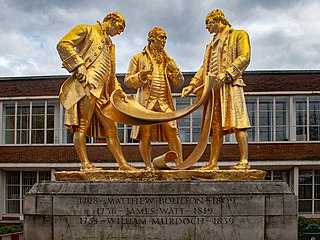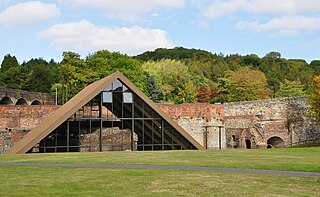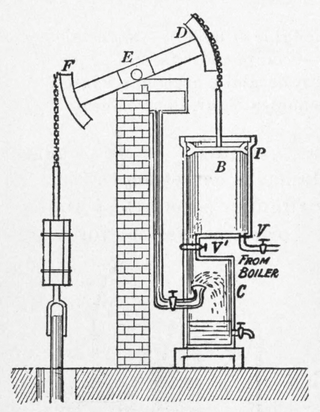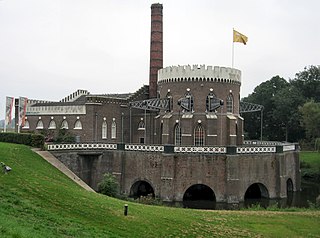Related Research Articles

A steam engine is a heat engine that performs mechanical work using steam as its working fluid. The steam engine uses the force produced by steam pressure to push a piston back and forth inside a cylinder. This pushing force can be transformed, by a connecting rod and crank, into rotational force for work. The term "steam engine" is most commonly applied to reciprocating engines as just described, although some authorities have also referred to the steam turbine and devices such as Hero's aeolipile as "steam engines". The essential feature of steam engines is that they are external combustion engines, where the working fluid is separated from the combustion products. The ideal thermodynamic cycle used to analyze this process is called the Rankine cycle. In general usage, the term steam engine can refer to either complete steam plants, such as railway steam locomotives and portable engines, or may refer to the piston or turbine machinery alone, as in the beam engine and stationary steam engine.

Thomas Newcomen was an English inventor who created the atmospheric engine, the first practical fuel-burning engine in 1712. He was an ironmonger by trade and a Baptist lay preacher by calling.

Thomas Savery was an English inventor and engineer. He invented the first commercially used steam-powered device, a steam pump which is often referred to as the "Savery engine". Savery's steam pump was a revolutionary method of pumping water, which improved mine drainage and made widespread public water supply practicable.

The atmospheric engine was invented by Thomas Newcomen in 1712, and is often referred to as the Newcomen fire engine or simply as a Newcomen engine. The engine was operated by condensing steam drawn into the cylinder, thereby creating a partial vacuum which allowed the atmospheric pressure to push the piston into the cylinder. It was historically significant as the first practical device to harness steam to produce mechanical work. Newcomen engines were used throughout Britain and Europe, principally to pump water out of mines. Hundreds were constructed throughout the 18th century.

The Watt steam engine design became synonymous with steam engines, and it was many years before significantly new designs began to replace the basic Watt design.

Boulton & Watt was an early British engineering and manufacturing firm in the business of designing and making marine and stationary steam engines. Founded in the English West Midlands around Birmingham in 1775 as a partnership between the English manufacturer Matthew Boulton and the Scottish engineer James Watt, the firm had a major role in the Industrial Revolution and grew to be a major producer of steam engines in the 19th century.

Stationary steam engines are fixed steam engines used for pumping or driving mills and factories, and for power generation. They are distinct from locomotive engines used on railways, traction engines for heavy steam haulage on roads, steam cars, agricultural engines used for ploughing or threshing, marine engines, and the steam turbines used as the mechanism of power generation for most nuclear power plants.

Coalbrookdale is a village in the Ironbridge Gorge and the Telford and Wrekin borough of Shropshire, England, containing a settlement of great significance in the history of iron ore smelting. It lies within the civil parish called the Gorge.
Steam power developed slowly over a period of several hundred years, progressing through expensive and fairly limited devices in the early 17th century, to useful pumps for mining in 1700, and then to Watt's improved steam engine designs in the late 18th century. It is these later designs, introduced just when the need for practical power was growing due to the Industrial Revolution, that truly made steam power commonplace.

Textile manufacture during the British Industrial Revolution was centred in south Lancashire and the towns on both sides of the Pennines in the United Kingdom. The main drivers of the Industrial Revolution were textile manufacturing, iron founding, steam power, oil drilling, the discovery of electricity and its many industrial applications, the telegraph and many others. Railroads, steamboats, the telegraph and other innovations massively increased worker productivity and raised standards of living by greatly reducing time spent during travel, transportation and communications.
Improvements to the steam engine were some of the most important technologies of the Industrial Revolution, although steam did not replace water power in importance in Britain until after the Industrial Revolution. From Englishman Thomas Newcomen's atmospheric engine, of 1712, through major developments by Scottish inventor and mechanical engineer James Watt, the steam engine began to be used in many industrial settings, not just in mining, where the first engines had been used to pump water from deep workings. Early mills had run successfully with water power, but by using a steam engine a factory could be located anywhere, not just close to a water source. Water power varied with the seasons and was not always available.

A beam engine is a type of steam engine where a pivoted overhead beam is used to apply the force from a vertical piston to a vertical connecting rod. This configuration, with the engine directly driving a pump, was first used by Thomas Newcomen around 1705 to remove water from mines in Cornwall. The efficiency of the engines was improved by engineers including James Watt, who added a separate condenser; Jonathan Hornblower and Arthur Woolf, who compounded the cylinders; and William McNaught, who devised a method of compounding an existing engine. Beam engines were first used to pump water out of mines or into canals but could be used to pump water to supplement the flow for a waterwheel powering a mill.

A Cornish engine is a type of steam engine developed in Cornwall, England, mainly for pumping water from a mine. It is a form of beam engine that uses steam at a higher pressure than the earlier engines designed by James Watt. The engines were also used for powering man engines to assist the underground miners' journeys to and from their working levels, for winching materials into and out of the mine, and for powering on-site ore stamping machinery.

The first recorded rudimentary steam engine was the aeolipile mentioned by Vitruvius between 30 and 15 BC and, described by Heron of Alexandria in 1st-century Roman Egypt. Several steam-powered devices were later experimented with or proposed, such as Taqi al-Din's steam jack, a steam turbine in 16th-century Ottoman Egypt, Denis Papin's working model of the steam digester in 1679 and Thomas Savery's steam pump in 17th-century England. In 1712, Thomas Newcomen's atmospheric engine became the first commercially successful engine using the principle of the piston and cylinder, which was the fundamental type of steam engine used until the early 20th century. The steam engine was used to pump water out of coal mines.

The Whitbread Engine preserved in the Powerhouse Museum in Sydney, Australia, built in 1785, is one of the first rotative steam engines ever built, and is the oldest surviving. A rotative engine is a type of beam engine where the reciprocating motion of the beam is converted to rotary motion, producing a continuous power source suitable for driving machinery.

A blowing engine is a large stationary steam engine or internal combustion engine directly coupled to air pumping cylinders. They deliver a very large quantity of air at a pressure lower than an air compressor, but greater than a centrifugal fan.
Shudehill Mill or Simpson's Mill was a very early cotton mill in Manchester city centre, England. It was built in 1782 by for Richard Arkwright and his partners and destroyed by fire in 1854. It was rebuilt and finally destroyed during the Manchester Blitz in 1940. One of Arkwright's larger mills, it was built three years before his patent lapsed. The mill had a 30 feet diameter water wheel and a Newcomen atmospheric engine was installed. Doubts remain as to why the engine was installed, whether it was a failed attempt to power a mill directly by steam or was modified to assist the wheel. It is possible that this engine, constructed by Hunt, could have been one of the 13 engines installed in Manchester mills by Joshua Wrigley. Water from the upper storage pond turned the water wheel to drive the mill. The steam engine recycled water from the lower storage pond to the upper storage pond. Three more Boulton and Watt engines were installed to power the increasing number of spindles.

Old Bess is an early beam engine built by the partnership of Boulton and Watt. The engine was constructed in 1777 and worked until 1848.

A cataract was a speed governing device used for early single-acting beam engines, particularly atmospheric engines and Cornish engines. It was a kind of water clock.
Resolution was an early beam engine, installed between 1781 and 1782 at Coalbrookdale as a water-returning engine to power the blast furnaces and ironworks there. It was one of the last water-returning engines to be constructed, before the rotative beam engine made this type of engine obsolete.
References
- 1 2 Wilson, P.N. (1963). "Water-Driven Prime Movers". Engineering Heritage. Vol. I. Institution of Mechanical Engineers. p. 32.
- ↑ Straker, Ernest (1969) [1931]. Wealden Iron. pp. 72–73.
- ↑ Butler, R. (1945). The History of Kirkstall Forge.
- ↑ Wilson (1963), p. 30.
- ↑ Manchester, William (1969). The Arms of Krupp . Michael Joseph. pp. 62–63, 65.
- ↑ "'Old Bess' engine by Boulton & Watt, 1777". Science Museum.
- ↑ Hills, Richard L. (1989). Power from Steam. Cambridge University Press. p. 37. ISBN 0-521-45834-X.
- ↑ Day, Joan (1973). Bristol Brass: The History of the Industry. Newton Abbot: David & Charles. pp. 80–81. ISBN 0 7153 6065 5.
- ↑ Rolt, L.T.C.; Allen, J.S.A. (1977). The Steam Engine of Thomas Newcomen. Moorland. p. 122.
- ↑ "Fire Engine at Warmley". Bristol Journal. 30 September 1749.
- ↑ Trinder, Barrie (1991) [1974]. The Darbys of Coalbrookdale. Phillimore & Co. / Ironbridge Gorge Museum Trust. pp. 10, 17–18. ISBN 0-85033-791-7.
- ↑ Belford, P. (2007). "Sublime cascades: Water and Power in Coalbrookdale" (PDF). Industrial Archaeology Review. 29 (2): 133–148. doi:10.1179/174581907X234027. S2CID 110369508. Archived from the original (PDF) on 22 February 2012.
- ↑ Hills 1989, p. 40.